The people are very important component of a country. They are its real wealth. It is they who make use of its resources and decide its policies. Ultimately a country is known by its people. Thus a country’s population is the total number of people living in it at a particular point of time.
Population of country continually changes due to birth and death rate and relocation of families in search of better sources of income and livelihood. The global population has seen a steep (near vertical) rise in the last half a century. The same can be said of India too where the population has doubled (from 548.2 million to 1210.2 million) in forty years (1971 to 2011) and almost tripled since 1951. This rapid growth in the country’s population has had its attendant effect on the lives of the people and engendered
a number of issues such as poverty, unemployment, pollution, etc.
| Demography |
|---|
| Demography is the science of population derived from the Latin word ‘demos’ which means people. It is concerned with the quantitative study of the size, structure, characteristics and territorial distribution of human populations and the changes that occur to them. Also concerned with the study of underlying causes or determinants of population phenomenon. Demographic study gives the capability of the territory to accommodate different populations in different point of time. |
Malthusian Theory of Population Growth
Malthus ’s theory of population growth was outlined in his Essay on Population (1798). He argued that human populations tend to grow at a much faster rate than the rate at which the means of human subsistence (specially food, but also clothing and other agriculture-based products) can grow. Therefore humanity is condemned to live in poverty forever because the growth of agricultural production will always be overtaken by population growth. While population rises in geometric progression (i .e., like 2,
4, 8, 16, 32 etc .), agricultural production can only grow in arithmetic progression (i.e., like 2, 4, 6, 8, 10 etc.).
Because population growth always outstrips growth in production of subsistence resources, the only way to increase prosperity is by controlling the growth of population. Unfortunately , humanity has only a limited ability to voluntarily reduce the growth of its population (through ‘preventive checks’ such as postponing marriage or practicing sexual abstinence or celibacy).
population growth always outstrips growth in production of subsistence resources, the only way to increase prosperity is by controlling the growth of population. Unfortunately , humanity has only a limited ability to voluntarily reduce the growth of its population (through ‘preventive checks’ such
as postponing marriage or practicing sexual abstinence or celibacy).
Malthus believed therefore that ‘positive checks’ to population growth – in the form of famines and diseases – were inevitable because they were nature’s way of dealing with the imbalance between food supply and increasing population.’
However, historical experience of European countries has refuted this. The pattern of population growth began to change in the latter half of nineteenth century, and by the end of the first quarter of the twentieth century these changes were quite dramatic. Birth rates had declined, and outbreaks of epidemic diseases were being controlled. Malthus’s predictions were proved false because both food production and standards of living continued to rise despite the rapid growth of population. Similarly he has failed to envisage that government will encourage people to go for contraception in order to control population.
Theory of Demographic Transition
This suggests that population growth is linked to overall levels of economic development and that every society follows a typical pattern of development related population growth. There are three basic phases of population growth. The first stage is that of low population growth in a society that is underdeveloped and technologically backward. Growth rates are low because both the death rate and the birth rate are very high, so that the difference between the two (or the net growth rate) is low.
The third (and last) stage is also one of low growth in a developed society where both death rate and birth rate have been reduced considerably and the difference between them is again small. Between these two stages is a transitional stage of movement from a backward to an advanced stage, and this stage is characterised by very high rates of growth of population.
This ‘population explosion’ happens because death rates are brought down relatively quickly through advanced methods of disease control, public health, and better nutrition. However, it takes longer for society to adjust to change and alter its reproductive behaviour (which was evolved during the period of poverty and high death rates) to suit the new situation of relative prosperity and longer life spans. This kind of transition was effected in Western Europe during the late nineteenth and early twentieth century. More or less similar patterns are followed in the less developed countries that are struggling to reduce the birth rate in keeping with the falling mortality rate. In India too, the demographic transition is not yet complete as the mortality rate has been reduced but the birth rate has not been brought down to the same extent.

India: Population and Dynamics
Size, Growth, Composition and Distribution
The size and growth of population are two important components of the demographic phenomena in a
developing country like India. After China, India is the second most populous country, with its population at 1,21,05,69,573 in 2011, in the world. The United Nations, The World Population Prospects report 2017, estimates that India could overtake China as the most populous country by 2024 and its population could touch 1.5 billion in 2030.
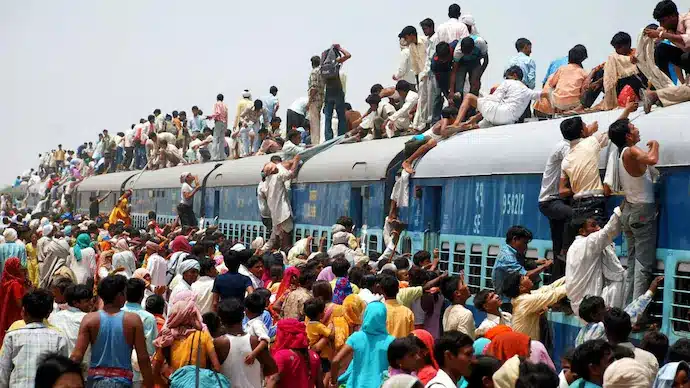
Between 1901-1951 the average annual growth rate did not exceed 1.33%, a modest rate of growth. In fact
between 1911 and 1921 there was a negative rate of growth of – 0.03%. This was because of the influenza epidemic during 1918-19 which killed about 12.5 million persons or 5% of the total population of the country. The growth rate of population substantially increased after independence from British rule going up to 2.2% during 1961-1981. Since then although the annual growth rate has decreased it remains one of the highest in the developing world. According to census 2011, annual growth rate of census is 1.3%.
According to 2011 census (a decennial official count of the population) data:
- Indian population comprises 62.31 crores males and 58.74 crores females.
- 68.85 per cent of the total population lived in the rural areas as compared to 31.15 per cent in the urban areas.
- Density of population is 382 persons per sq. km.
- Sex ratio of females is 943 females per 1000 males.
- Child sex ratio for females is 919 per 1000 males.
- Population in the age group of 0-6 years is 13.6 per cent of the total population.
India added 18.19 crores to its absolute population in ten years between the 2001 and 2011 census which is approximately a decadal growth rate of 17.7 per cent. The rural and urban population grew at a 12.3 and 31.8 per cent (decadal) respectively. For the first time since independence the population growth rate was less than 20 per cent. The male and female population grew at 17.1 and 18.3 per cent (decadal) respectively. The urban female population grew at 34 per cent (decadal) compared to urban male population growth of 29.8 per cent (decadal). In rural areas, while the male population grew at 12.1 per
cent (decadal) female population grew at 12.5 per cent (decadal).
Determinants of population growth can be divided into following broad categories:
Age Structure of the Indian Population
India has a very young population – that is, the majority of Indians tend to be young, and the average age is also less than that for most other countries, the share of the under 15 age group in the total population has come down from its highest level of 42% in 1971 to 35% in 2001. The share of the 15-60 age group has increased slightly from 53% to 59%, while the share of the 60+ age group is very small but it has begun to increase (from 5% to 7%) over the same period. But the age composition of the Indian population is expected to change significantly in the next two decades. Most of this change will be at the two ends of the age spectrum – as Table 2 shows, the 0 -1 4 age group will reduce its share by about 11% (from 34% in 2001 to 23% in 2026) while the 60 plus age group will increase its share by about 5% (from 7% in 2001 to about 12% in 2026.)
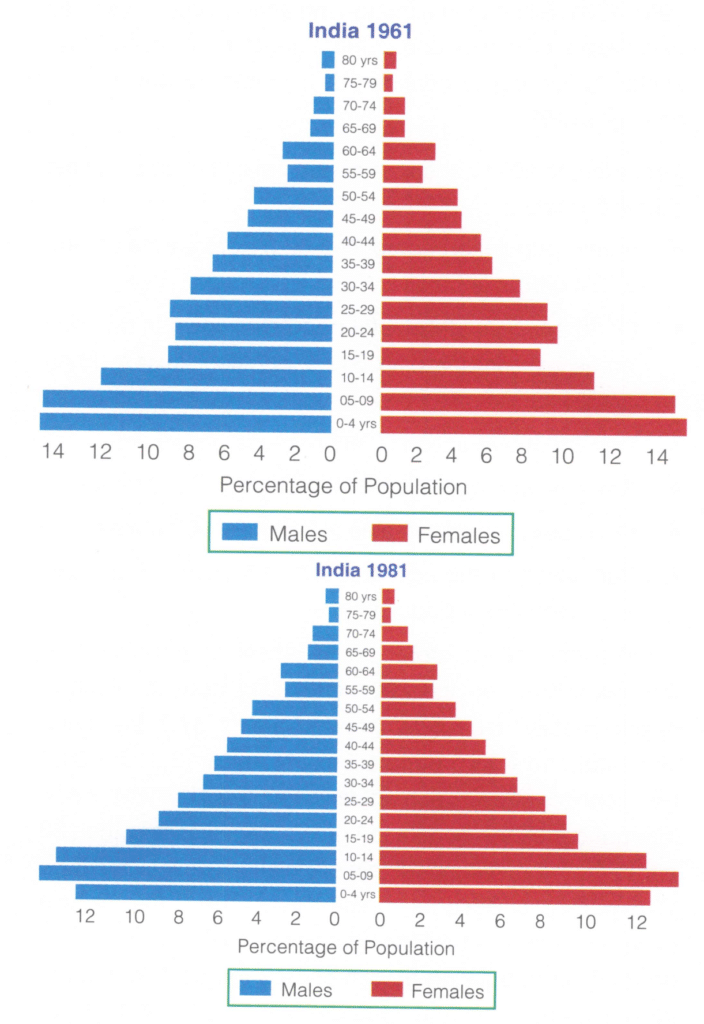
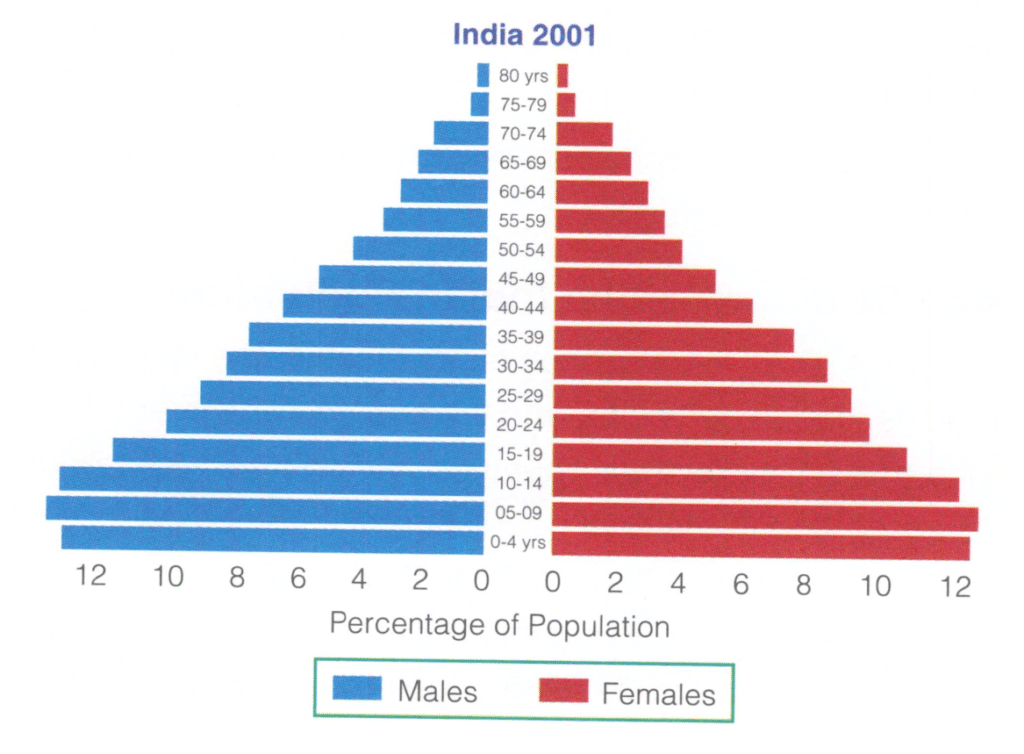
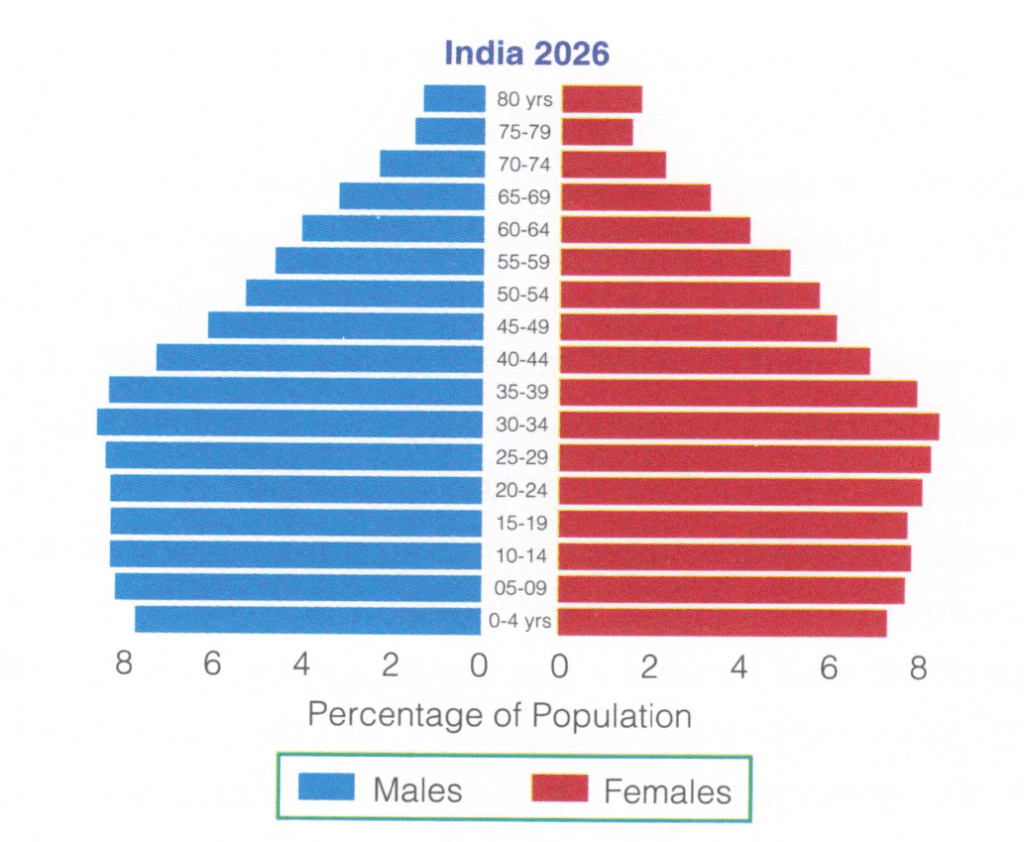
Components of Population Growth
Till 1921, both birth rates and death rates were high, after it death rates fell sharply but the birth rate only fell slightly. Demographers have listed three factors as the most important factor of demographic change:
Birth Rate
Most common used indicator of birth rate is crude Birth rate. Generally expressed in number of live births per 1000. According to demographic transition theory birth rate remains high for a nation from its under developed to developing phase. According to 2011 census, it is around 21.8% in India.
Factors that contribute to lower rate of decline in birth rate are:
- Customs of early marriage.
- Preference for male Child. Dominance of Patriarchal values.
- Dependency of Women.
- High rates of Illiteracy.
Death Rate
Death rate or mortality is measured through crude death rate, expectation of life at birth, infant mortality rate and maternal mortality rate. There would be absolute growth in population if death rate is lower than the birth rate. Up to 1921, the crude death rates had been quite high , around 40-50 per thousand populations. From 1911-21 to 1971- SI in a period of 60 years the average annual death rate
declined from 48.6 per thousand to 14.9 per thousand. And in census 2011 it was at around 7.
Increased control over famines and epidemic diseases due to improvement in medical cure, programs for mass vaccination and efforts to improve sanitation has helped in controlling epidemics and thus bringing down the mortality. One of the main factors responsible for the growth of population is the declining death rates have not been accompanied by corresponding decline in birth rates.
| Fertility |
|---|
| Fertility rate refers to number of live births per 1000 women in the child bearing age group, usually taken to be 15-49 years. It helps in determining the growth or decline in population. Wide variation in fertility rates across states of India has been seen. States like Tamil Nadu, Kerala have managed to bring down their fertility rate to 2.1 and 1.8 respectively. Tamil Nadu has a fertility rate of 2.1 which is also the replacement level (required to replace herself and her spouse.) But at the same time there are states like Bihar, Uttar Pradesh, which still have high total fertility rate touching around 4. |
Migration
Migration can be defined broadly as permanent or semi permanent change of residence. Migration plays a very important role in the distribution of population in the country and is a response of humans to economic , social and demographic forces in the environment. Four types of migration streams are Rural to Rural, Rural to Urban, Urban to Urban and Urban to rural.
Migration can be caused by the following factors:

- Economic Factor:
- It may lead to push and pull factors. Poverty, low productivity, unemployment, exhaustion of natural resources are some of the push factors. Similarly pull factors like opportunities which may be of better employment, better working condition and better amenities of life. There is one more factor seen in case of India push back factors, as unemployment and marginal employment in cities increases it pushes them back.
- Political Factor:
- Some political parties in Maharashtra follow sons of soil policy which leads to forced migration. Similar policies are visible in Tamil Nadu and few other places.
- Social Factors:
- it includes marriage induced migration. Sometimes even caste and communal violence forces the victims to shift to new places.
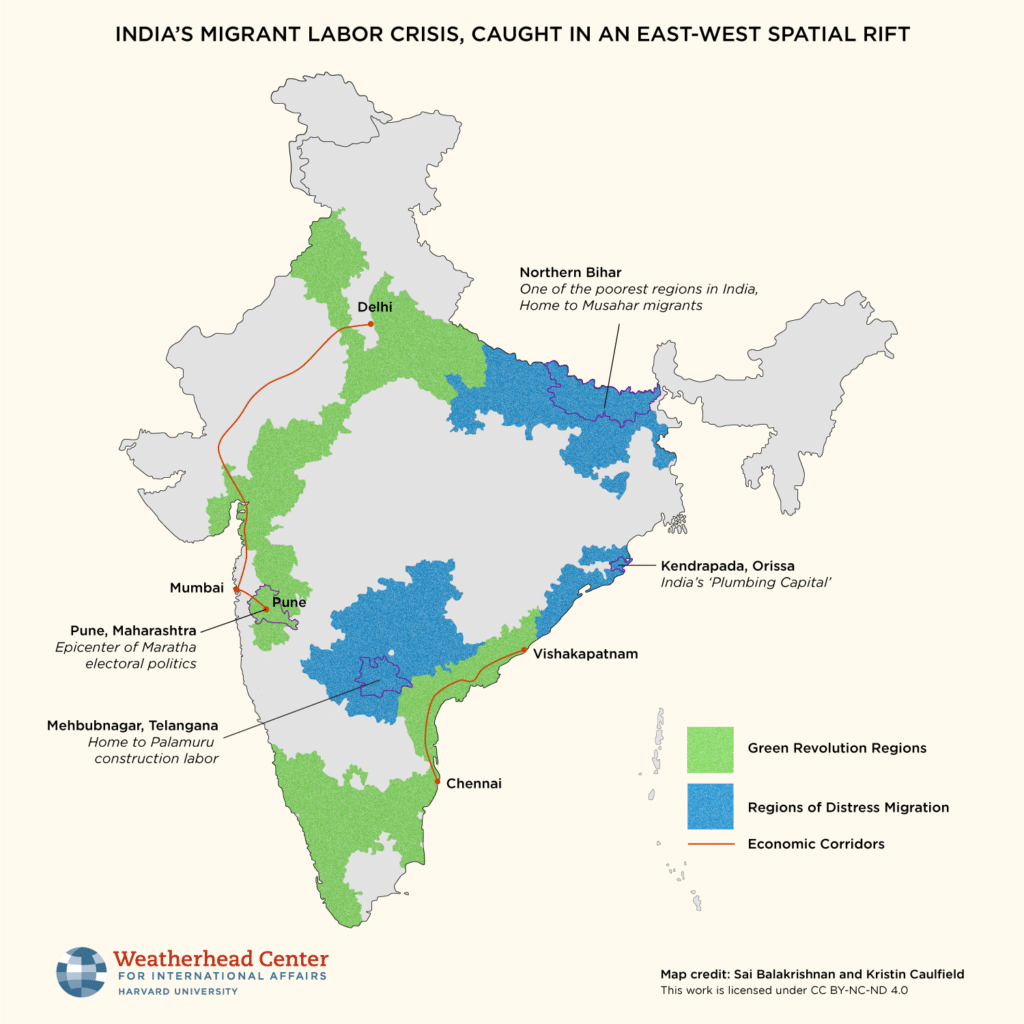
Trends of Migration in India
Four types of migration streams are:
- Rural to Rural:
- If Most of the migrants were females, it becomes obvious that marriage was the prime reason for such migration. Generally, about one-half of male intra-state migrants belong to rural-to-rural category. Most of these RR migrants are from backward states like Uttar Pradesh, Bihar, Orissa, Madhya Pradesh and Rajasthan. It is obvious that migrants moved from their place of origin in search of better jobs in agricultural farms or other establishments in rural areas.
- • Rural to Urban:
- Mostly it takes place from underdeveloped states like Rajasthan, Uttar Pradesh, Bihar, Andhra Pradesh and Kerala. Migrants had a tendency to move into comparatively developed regions like West Bengal, Maharashtra, the National Capital Territory of Delhi, Chandigarh, and Andaman and Nicobar Islands. Most of the major metropolitan cities of India are currently witnessing heavy inmigration and consequent population growth due to work opportunities offered by these cities. Cities like Delhi, for example, are badly affected by huge influx of migrants.
- Urban to Urban:
- Generally people with resources have moved from tier2 to tierl cities for higher education or to tap formal sector employment opportunity. Similarly City pollution has also triggered a reverse migration trend in India – from the city to the countryside or tier 2 cities. While it is a mere trickle compared to the inexorable rural to urban flow , some high-profile moves have made the news in recent years, such as the departure of Costa Rica’s ambassador to southern India because Delhi’s air had made her sick.
- Urban to Rural:
- this can also be considered as reverse migration. In India, reverse migration has gained momentum over the past decade, due to government support and initiatives of various organizations.
The Saansad Adarsh Gram Yojana is an initiative to improve the country one village at a time. The concept of Providing Urban Amenities in Rural Areas was proposed by our Late President Dr. APJ Abdul Kalam, to achieve rural economic development in India.
NGOs like Swades Foundation get an upper hand with their 360-degree intervention across 2000 villages from 6 blocks in Raigad district. Their holistic development model has enabled water supply and toilets across thousands of homes. Their intervention in health and education has upgraded general awareness levels and improved standard of living in their geography to a great extent.
The trend of reverse migration is thus set to promote maximum utilization of unproductive land, making villages independent entities.
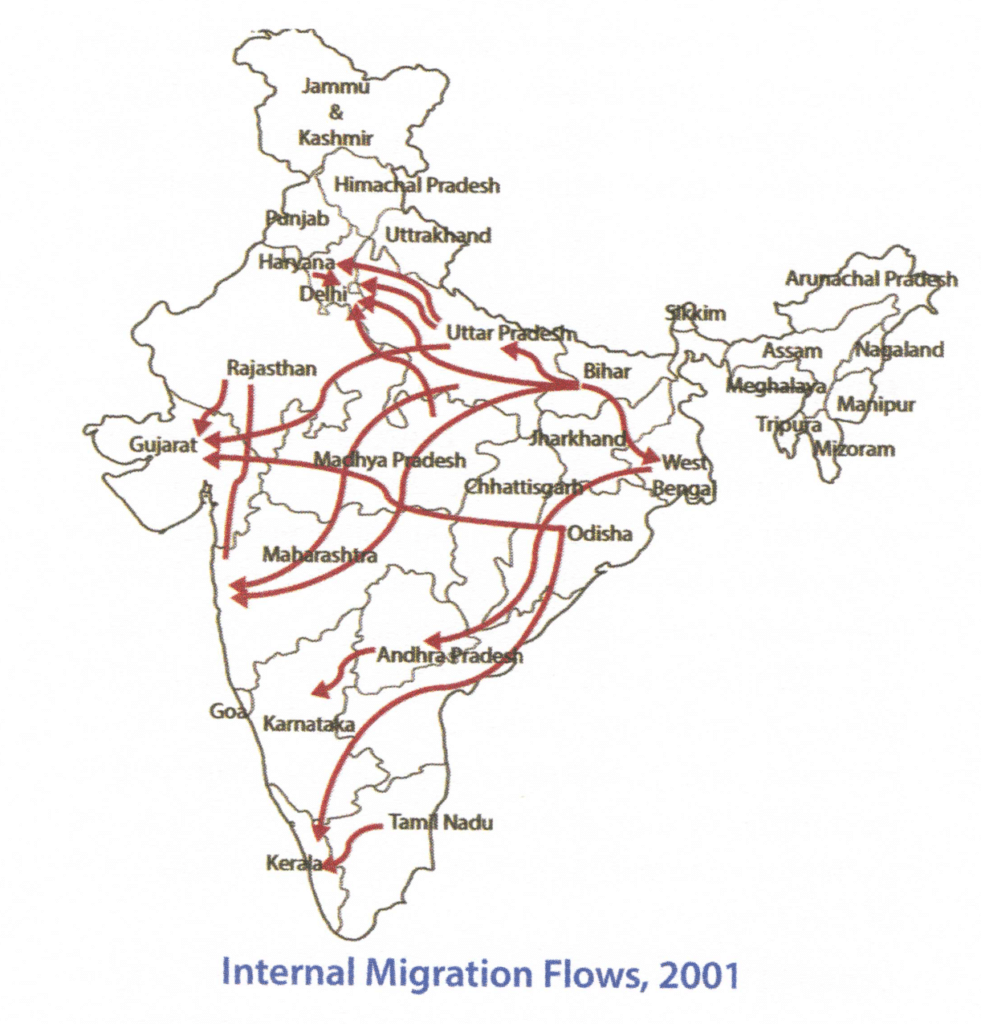
Trend of International Migration
India has had one of the most diverse and complex migration histories in the world, from an early indentured labour situation in the far colonies of the British to the current highly skilled migrants in North America and low skilled migrants in the Middle East India regulates external labour migration flows, for which the 1983 Emigration Act provides the necessary legal framework. The office of the Protector of Emigrants, Ministry of Labour , is empowered by law to regulate the deployment of Indian nationals seeking foreign employment.
The main objective of state intervention is to ensure that nationals obtain legally valid employment abroad under acceptable conditions. This is achieved mainly by setting minimum employment standards and verifying employment contracts; regulating recruitment through licensing the agents, issuing emigration clearances for certain categories of emigrants, especially those considered less able to protect their own interests, and handling public grievances related to violation of employment contracts and recruitment abuse.
Two distinct types of labour migration have been taking place from India
People with technical skills and professional expertise migrate to countries such as the USA, Canada, UK, EU and Australia as permanent migrants. Migrants on the skilled side move to developed countries in search of jobs that suit their qualifications. Skilled workers usually take up healthcare, management, financial services or information technology jobs in countries like USA, UK, Australia and the European Union.
Unskilled and semi-skilled workers migrate mainly to oil exporting countries of the Middle East on temporary contracts. Migrants at the lower end of the market comprise mostly unskilled casual labourers or those who own or hire small means of livelihood such as carts or rickshaws and are self-employed. Unskilled labour looks to move to the Middle East majorly Saudi Arabia and UAE in search of construction and retail trade jobs as these economies offer more jobs due to shortage of labour in the region. They are economically sound countries offering better standard of living and income to unskilled labourers as compared to India.
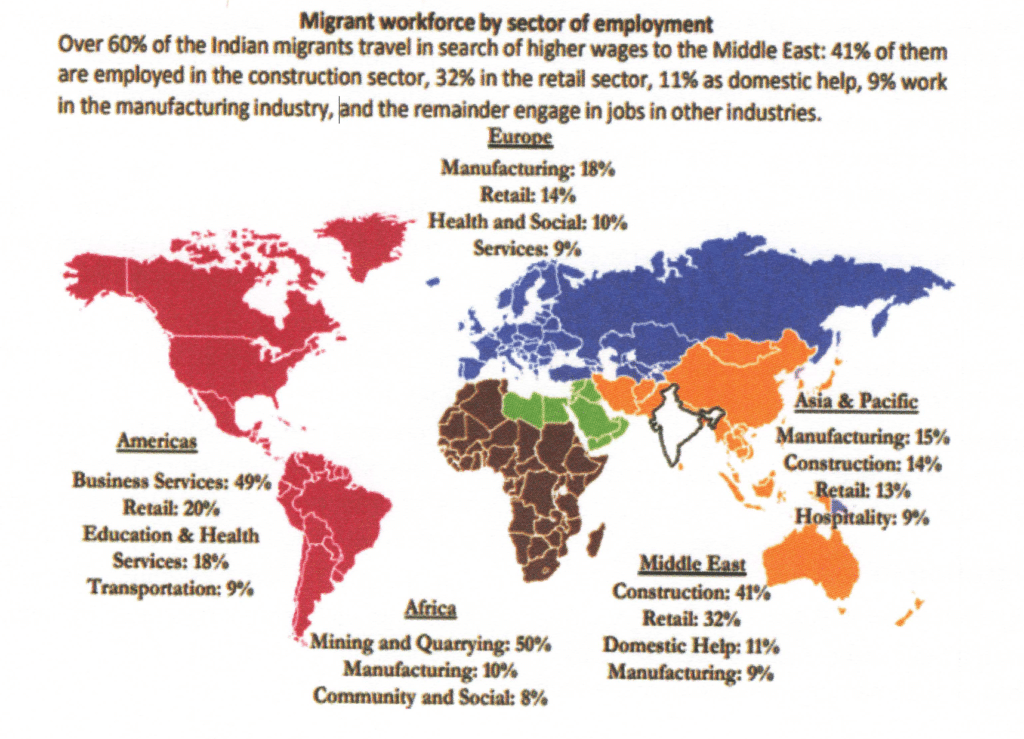
| Benefits and Costs of International Migration | |||||
|---|---|---|---|---|---|
| Individual | Source Countries | Destination Countries | |||
| Positive | Negative | Positive | Negative | Positive | Negative |
| Employment | Underemployment in receiving country | Remittances: spilloever effects on education, local development | Brain drain, constraining growth | Economic growth and development | Competition for low skilled jobs |
| Wage Improvement | Subject to abuse | Reduced pressure to create jobs | Labour Shortage | Address ageing and working population decline | Downward pressure on wages in developed countries |
| Welfare enhancement | Costly / regulation regarding migration | Fulfilling for shortage in skill | |||
| Better returns on skills and education | |||||
Population Policy
UNEP defines population policy as an effort to affect the size, structure and distribution or characteristics of population. India has the distinction of being the first country in the world to have a fully government-supported family planning programme. This is not an overnight development. The foundations were laid in the early part of the twentieth century.
India’s population policy aims to enhance the quality of life and increase individual happiness. The objectives of population policy are:
- To influence the rate and pattern of population growth in socially desirable directions.
- Decreasing mortality.
- Decreasing birth rate
- Creating awareness among the masses regarding consequences of galloping population.
- Procuring necessary contraceptives.
Family Planning
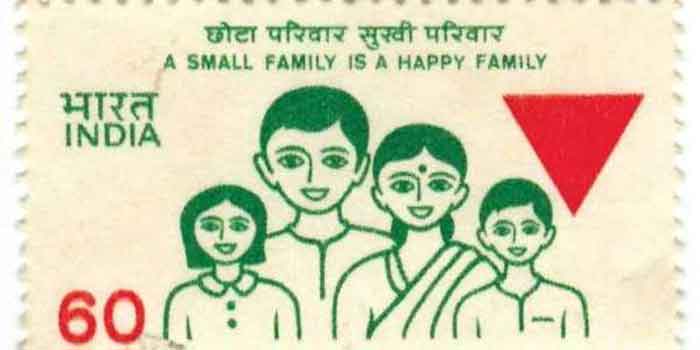
According to WHO, family planning is a way of thinking and living that is adopted voluntarily, upon the basis of knowledge, attitudes and responsible decisions by individuals and couples, in order to promote the health and welfare of the family group and thus contribute effectively to the social development of the country. Due to the rising focus upon family planning in 2017 around 130 million women are using modern methods of contraception.
At the level of the family, family planning implies having only the desired number of children. Thus family planning implies both limitation of the family to a number considered appropriate to the resources of the family as well as proper spacing between the children. The adoption of family planning, obviously, requires conscious efforts made by the couple to control conception.
As a social movement, family planning implies an organized effort by a group of people to initiate change in the childbearing practices of the people by creating a favourable atmosphere.
A family planning programme involves a coordinated group of activities, maintained over a period of time, and aimed at fostering a change in the childbearing behaviour of the females. The aim of the family planning programme may either be to improve the health status of women and their children and/or of reducing the birth rate, and thus reducing the population growth rate of the country. Most countries with a population control policy also emphasize the health aspects of family planning.
The various components of the family planning programme are:
- Information, Education and Communication Activities,
- Contraceptives: Supplies and Services,
- Training of Personnel,
- Research, and
- Administrative Infrastructure.
The family planning programme in India aims at the welfare of the family.
Emerging Issues
Ageing
Ageing of a population implies increase in the proportion of aged people, i.e. people above the age of 60 years, in the population. Countries like Japan are facing enormous pressure as a significant chunk of their population is now approaching old age and dependency ratio is increasing. India too is slowly moving into that direction with more than 100 million people aged above 60 in India as per census 2011.
Sex Ratio
Sex Ratio is an important indicator of gender balance in the population. Indian census prefers to define sex ratio as number of females per 1000 males though world over it is number of males per 1000 females. It reflects the socio-cultural values of a society. Poor sex ratio reflects a preference for male child in a society.
While there has been gain in the overall sex ratio in 2011 compared to 2001 by 7 points but there has been decline in child sex ratio by 13 points which is a matter of great concern.
Factors responsible for poor sex ratio in India:
Foeticide: Female foeticide or the killing of girl babies in the womb due to religious or cultural beliefs, more specifically due to the preference for male child.
Infanticide: Neglect of girl child in infancy leading to higher infant death rates or at times killing girl child at birth.
Poverty: Poverty is one of the factors responsible for the declining sex ratio. States with lower poverty levels like Tamil Nadu have high sex ratio. Women and girl child are denied of nutritious food and healthy life both due to preference for male child and poverty. Violence Against Women: Women are often subjected to assorted violence, which includes dowry deaths, honour killings, sexual violence and so on.
Migration: Migration is also emerging as one of the factors. Male bread earners often leave their native places, leaving behind women in the families. This leads to skewed sex ratio in urban areas.
State-level child sex ratios offer greater cause for worry as the most prosperous regions of India like Haryana, Punjab have one of the lowest sex ratios in the country. Six states and union territories have a child sex ratio below 900 females per 1000. The problem of selective abortion is largely a socio-cultural issue rather than poverty, ignorance or lack of resources. In Haryana relatively backward regions like Mewat, Fatehabad have better sex ratio than the rest of the state.
Impact of the poor sex ratio on society is manifold:
- Unhealthy social mix due to demographic distortion.
- Increasing incidences of sexual violence and trafficking.
- Instances of polygamy.
- Importing brides and human trafficking of females to deficit areas as reported in some parts of Haryana.
- Reinforces other social evils like dowry deaths.
Government initiatives to counter the declining sex ratio:
- PCPNDT Act (Pre Conception and Pre Natal Diagnostics Techniques Act) has been passed which makes sex determination as illegal.
- State specific schemes like cash incentive, Apni Beti Apna Dhan, Laadli in Haryana, education made free till graduation.
- Government of India has launched Beti Bachao Beti Padhao scheme to promote girl child and her education.
- The Ministry of finance has initiated Sukanya Samriddhi Yojana, a small deposit scheme for the girl child launched as a part of the ‘Beti Bachao Beti Padhao’ campaign, to meet the requirement of her higher education expenses.
- Technological Solutions are being experimented, example a Silent Observer tool is being fitted along with ultrasound machines in states like Haryana, Maharashtra, to prevent ante-natal sex determination.
However , the measures had not been proved to be very effective, example under PCPNDT Act very few convictions have been made till date. A mass awareness campaign to sensitize the people along with cultural shift in values is required so that females are treated equally in our society and so that their sex ratio can be improved.
Child and Infant Mortality
Infant Mortality Rate (IMR) is generally taken as death rate of children of age 0-1 year per 1000 children born. Neonatal Mortality (NNM) and Post-Natal Mortality (PNM) are the components of IMR. India failed to meet its Millennium Development Goals (MDGs) target of halving the IMR by 2015. India experiences a huge difference in rural-urban rates of Infant deaths. Around two-thirds of infant deaths happen in babies less than four weeks old.
Causes
Various reasons attributed to high child mortality rate are:
- Female Autonomy:
- Female in many Indian states do not enjoy the autonomy to decide the age of marriage and when married they cannot decide the age to give birth or even the spacing between births of their children, which has direct implication of the health of the new child.
- Female Literacy:
- Female education still remains low on priority in rural areas. Thus, new mothers and pregnant women lack the basic fundamentals of pregnancy as well as post baby care. Moreover, they
are unaware of the danger signs of infant illnesses and thus don’t seek help promptly.
- Female education still remains low on priority in rural areas. Thus, new mothers and pregnant women lack the basic fundamentals of pregnancy as well as post baby care. Moreover, they
- Access to Amenities:
- Another major reason is that still many women in India do not have sufficient access to clean water, nutritious food and regular medical assistance.
- Transport Infrastructure:
- Even the transport infrastructure of a State can have a role in reducing infant mortality, because the longer people take to reach hospitals when their child is sick, the higher the risk of death.
- Poor Government Spending:
- Across the world, there is a link between government per-capita spending on health and infant mortality. According to the WHO, India’s spending lags behind that of Sub-Saharan Africa.
- Malnutrition:
- High rates of malnutrition among women in India is yet another leading cause of infant mortality in India. An anemic mother gives birth to a low weight baby and antenatal care is severely lacking in the country. 24% to 37% of Indian babies have a birth weight below 2500 grams and according to World health organisations guideline these babies are at a higher risk of mortality .
- Poor Immunization:
- Children an India suffer from a number of diseases like diphtheria, pertussis, measles, polio etc. because of poor immunization. Diarrhoea alone claims 30% children deaths in India.
Consequences
High Infant mortality rate has several consequences:
- These are unambiguous indicators of backwardness and poverty.
- Couple may go for a larger number of children with the hope that few would survive. Mortality of children have an adverse effect on the health of mothers.
- It also becomes an economic burden for poor women who are members of labour force in unorganized sector.
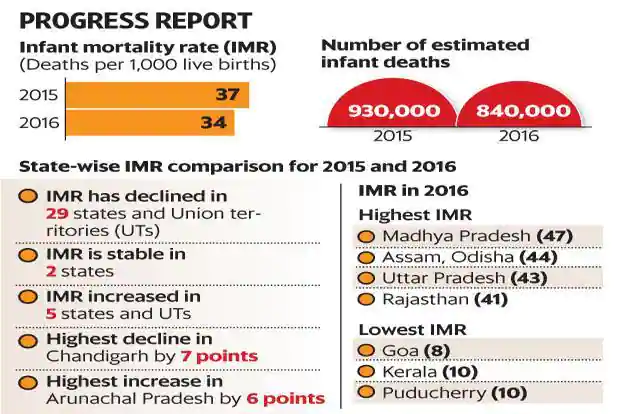
Currently according to sample registration bulletin India has able to decline by 8% in 2016 and it has declined to 34 from 37 in 2015. It shows the approach of Government has started to show dividends and special focus on low performing states is paying off.
Reproductive Health
Reproductive health is a state of complete physical, mental and social well-being in all matters related to the reproductive system. It implies that people are able to have a satisfying and safe sex life, the capability to reproduce, and the freedom to decide if, when, and how often to do so.
To maintain one’s sexual and reproductive health, people need access to accurate information and the safe, effective, affordable and acceptable contraception method of their choice. They must be informed and empowered to protect themselves from sexually transmitted infections. And when they decide to have children, women must have access to services that can help them have a fit pregnancy, safe
delivery and healthy baby.
Reproductive health is an important social and demographic indicator which is closely related to maternal mortality , neo-natal mortality and overall health. Maternal death in turn is an important indicator of the reach of effective clinical health services to the poor and one of the composite measures to assess the country’s progress.
In India malnutrition, poor adult education, age of marriage and lack of medical infrastructure are key factors for poor reproductive health. National Population policy 2000 had a specific focus on reproductive health and it has acknowledged sexual and reproductive needs of adolescents. Government has launched various schemes with special focus upon reproductive health of adolescent girls like Kishori Shakti Yojana, Nehru Yuva Kendra etc.
Dependency Ratio
Dependency ratio is a measure comparing the portion of population which is composed of dependents that is elderly people who are too old to work, children who are too young to work and other sections of population who are not able to work due to some physical infirmity. Thus, dependency ratio is roughly equal to the population below 15 and above 60 divided by population in the 15-60 age group and the ratio is usually expressed in percentage. High dependency ratio is a cause of worry as it becomes difficult for a relatively smaller proportion of working-age people to carry the burden of providing for a relatively larger proportion of dependents. In case of India ratio of population aged 0-14 and 65+ per 100 people of aged between 15-64 years is around 52.2
Causes of High Population
- Demographic: Improvement in health conditions and control of diseases due to advancement in medical conditions has led to decline in death rate but birth rate has not decreased by a large margin.
- Economic: Economically weaker states often are the leaders in population growth, attesting the theory that economic status of family is inversely proportional to number of children.
- Education: It is closely linked with fertility rates. Less educated families are at less informed or ignorant of latest family planning techniques.
- Social: Desirability of male children, a common social practice in patriarchal societies like India, can lead to high and skewed birth rates.
- Natural Calamities: India has advanced in science and which has helped in preventing occurrence of any natural calamities unlike between 1911-21.
- Age of Marriage: Lower age of marriage is also considered an important factor towards increase in birth rates.
- Cultural: Cultural barriers against use of contraceptive in various regions and religions can also influence the population size.
Effects of Overpopulation
Overpopulation is a serious threat to our own existence, India is now home to 1.2 billion and is expected to grow 1.8 billion before stabilizing around the middle of century, if sufficient measures are taken. It leads to political, societal and economic problems such as inequitable resource distribution, poor living conditions, failure of health infrastructure and others. Excessive population leads to dysfunctionality of working institutions, dents all plans to improve the country’s infrastructure, and renders social welfare initiatives ineffective.
Social
- Crime:
- Population explosion has direct correlation with poverty and due to resource constraints and lack of employment opportunities leads to unemployment. Unemployment in turn leads to frustration and anger among the educated youth, who are drawn to social crimes robbery, beggary, prostitution, murder etc. The terrorist activities that we see today in various parts of the country example Jammu and Kashmir, is a reflection of the frustration among educated unemployed youth.
- Minority-Majority Divide:
- Overpopulation in certain communities can give rise to fears of their dominance over the minorities and loss of identity.
Thus it can create fissures in the social fabric on the basis of religion and foment communalism.
Economic
- Unemployment:
- Overpopulation results in huge army of labour force, but due to the shortage of capital resources it becomes difficult to provide gainful employment to the entire working population. Disguised unemployment in rural areas and open unemployment in urban areas is distinctly visible.
- Resource Scarcity:
- Overpopulation directly leads to over exploitation of natural resources and deterioration and degradation of the environment. Population in India has grown geometrically whereas the resources are either fixed or have grown arithmetically causing resource scarcity.
- Unequal Income Distribution:
- Overpopulation effects the investment requirement and capital formation of the government which is affecting the overall development work of the government. The situation is compounded by unemployment, inequitable distribution of food, rising poverty which are the main reasons behind the rise of inequitable distribution of wealth.
- Poverty:
- Unemployment, unequal distribution of income and resource scarcity all lead to pauperization of the people.
Political
Economic and societal aspects of a country influence its polity. The rising unemployment, poverty , inequitable distribution of money affects the law and order situation in the country. Also due to illiteracy political parties play caste politics and leading to disintegration of the country.
Environmental
Overpopulation is exerting pressure on land and the per capita availability of land is diminishing. Population explosion has led to environmental degradation, in form of pollution, loss of biodiversity, global warming, among others. The forest and agricultural land is decreasing at a faster rate. The effects of overpopulation are already being seen in metropolitan cities like Delhi, which is reeling under air pollution.
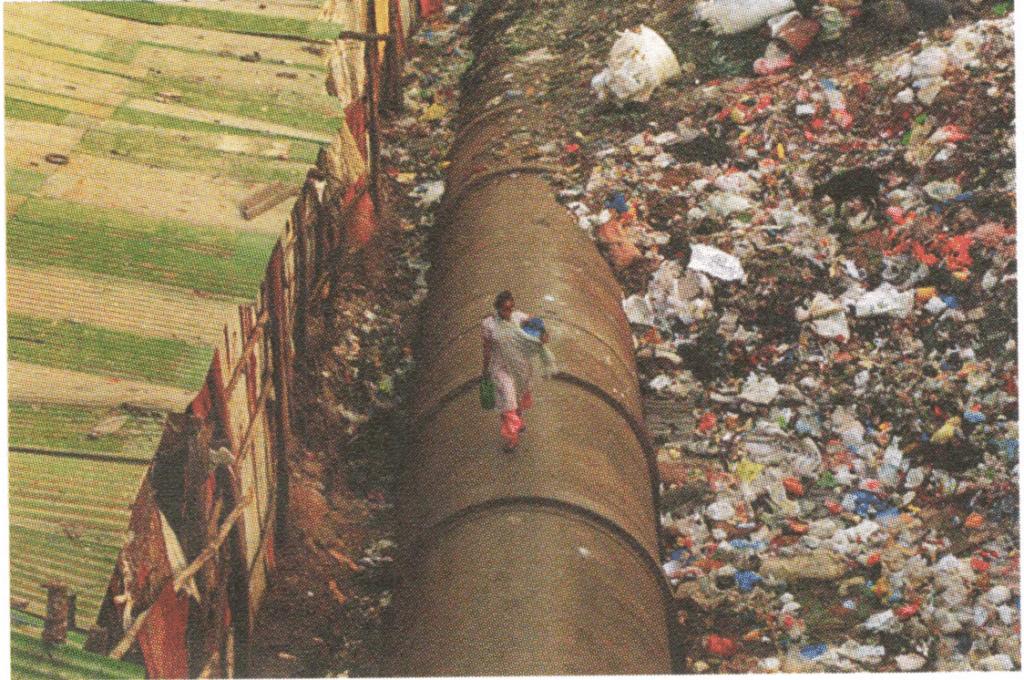
Health
Overpopulation is one of the major factors influencing the health of the people. The increase in population has led to issues like urban crowding and environmental changes that have resulted in the emergence of many infectious diseases. Population growth adds to the inability of governments to scale up health care systems and facilities.
Demography: A Dividend or Disaster
India’s 51% of the population of 1.1 billion people is under 25 and two-thirds under 35. It is believed India’s ‘youth bulge’, believed to last until 2050, could turn out to be its greatest asset (demographic dividend)- or a demographic disaster if the government fails to provide education and jobs for its burgeoning workforce. India has hit the “tipping point” where large number of young workers entering the labour force could unleash major economic gains by boosting savings and investment. China made a great economic leap forward when it reached that point in the early 1980s. Now the greying population resulting from Beijing’s one-child policy could slow its growth by 2030. By 2020, the average age of an Indian is expected to be 29 years, compared with 37 for China and 48 for Japan.
Economic Survey 2016-17: Highlights on Indian Demography
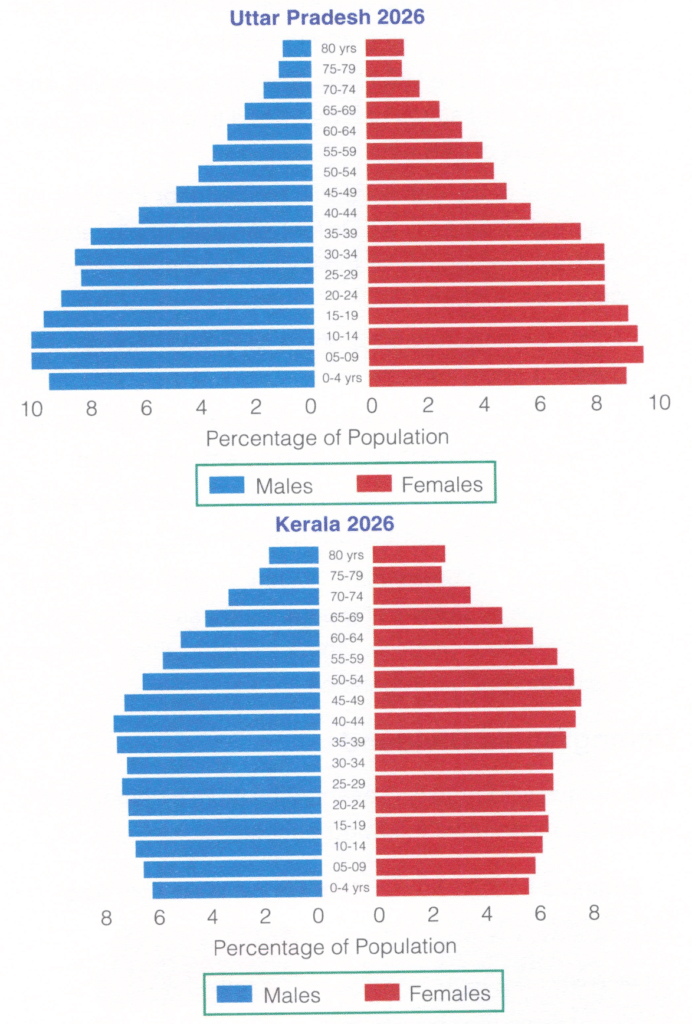
- India’s demographic cycle is about 10-30 years behind that of the Brazil, Korea and China, indicating
that the next few decades present an opportunity for India to catch up to their per capita income levels. - India’s working age (WA) to non-working age (NWA) ratio is likely to peak at 1.7, a much lower level than Brazil and China, both of which sustained a ratio greater than 1.7 for at least 25 years. India will remain close to its peak for a much longer period than other countries. This has following growth consequence:
- India should not expect to see growth surges or growth decelerations of the magnitudes experienced by the East Asian countries on account of the demographic dividend only.
- At the same time, India might be able to sustain high levels of growth (on account of the demographic dividend) for a longer time.
- There is a clear divide between peninsular India (West Bengal, Kerala, Karnataka, Tamil Nadu and Andhra Pradesh) and the hinterland states (MP, Rajasthan, UP and Bihar). The peninsular states exhibit a pattern that is closer to China and Korea, with sharp rises and declines in the working age population.
- This divide in the WA/NWA ratio of the peninsular and the hinterland states can be traced to the difference in their levels of TFR .
- The peak of the demographic dividend for India will be reached in the early 2020s for India as a whole; around 2020 for the peninsular India while hinterland India will peak later around 2040.
- Thus, demographically, there are two Indias, with different policy concerns:
- A soon-to begin-ageing India where the elderly and their needs will require greater attention;
- A young India where providing education, skills, and employment opportunities must be the focus.
- Although, heterogeneity within India offers the advantage of addressing some of these concerns via greater labour mobility, which would in effect reduce this demographic imbalance.
Demographic Dividend
If the unique opportunity presented by India’s demography is utilised, it can have following benefits:
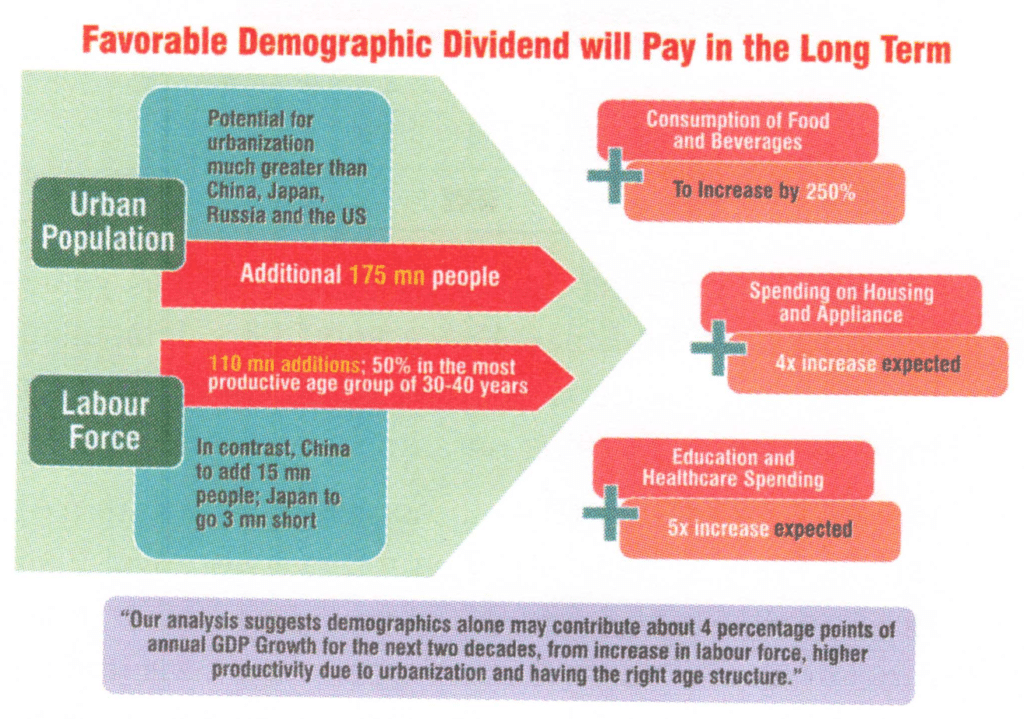
- The energy and vibrancy of youth would give a cutting edge to India’s economy, science and technology because of the youth’s capacity to take risk and innovative ideas.
- The share of working age population in the total population of India is expected to be around 65% till 2050.
- It is seen that states with higher growth in the working age population have grown faster than others.
- It is believed demographic dividend could add 2% points per annum to India’s per capita GDP growth.
- The dependency ratio will be less thus India would benefit from the savings, investment from the large labour force.
Demographic Disaster
However, the social cohesion may be badly affected if the economic gains are not inclusive, not able to provide jobs and able to raise the living standards of the youth. Lack of education, job opportunities and health care could muddle this rosy picture present in the foregoing discussion on demographic dividend. An unskilled, under-utilized, frustrated young population can derail the economic growth leading to a demographic disaster which could undermine harmony and breed violence.
- On education front the report card is abysmal and the literacy levels lag behind many developing countries including sub Saharan Africa. The education system is mired in corruption and teacher absenteeism rate of 25% is the second highest in the world behind only Uganda. According to Pratham report, only around 50% of fifth grade students can read books of class two and fail in basic addition and substraction.
- Similarly, the health infrastructure is poor and number of malnourished children is around 48% who tomorrow are going to be part of this demographic dividend.
- India added the fewest organized jobs in the last seven years across eight industries in the last few years. Contribution from unorganized sector jobs in 2017 will rise to 93% and 60% of those with jobs did not find employment for the whole year which indicates chronic underemployment.
- Automation is becoming the next big threat to our labour force as Mckinsey pointed out that 50-60% of the IT workforce is going to become irrelevant. The effects is getting visible already as our bellwether IT sector is laying off people and freezing of recruitment. Also Indians in US looking for job has went up by 10 fold.
- Formation of company is slowest and at the rate as was in 2009 and the existing ones growing at 2%, the lowest in many years.
- By 2045 it is believed that we are going to produce more unproductive than productive and we will have more unemployable than unemployed. We have been in the ‘demographic dividend’ state for two decades now and we are going to enter into a ‘demographic nightmare’ state in two decades now.
Thus to ensure this demographic dividend not turn into a demographic disaster, the only solution is to ensure more jobs in the services and manufacturing space, and need to move towards reforming the education system. The ill effects of low job creation are already apparent with increase in number of violent protests, rise in terrorism and other law and order situation.
Population and Poverty
The rapid growth of population aggravates the poverty of people as the growth of population exceeds the rate of growth in national income. Population growth not only creates difficulty in the removal of poverty but also lowers the per capita income which tends to increase poverty. The burden of this reduction in per capita income is born heavily by the poor people. Vice versa poverty also leads to population explosion as explained earlier.
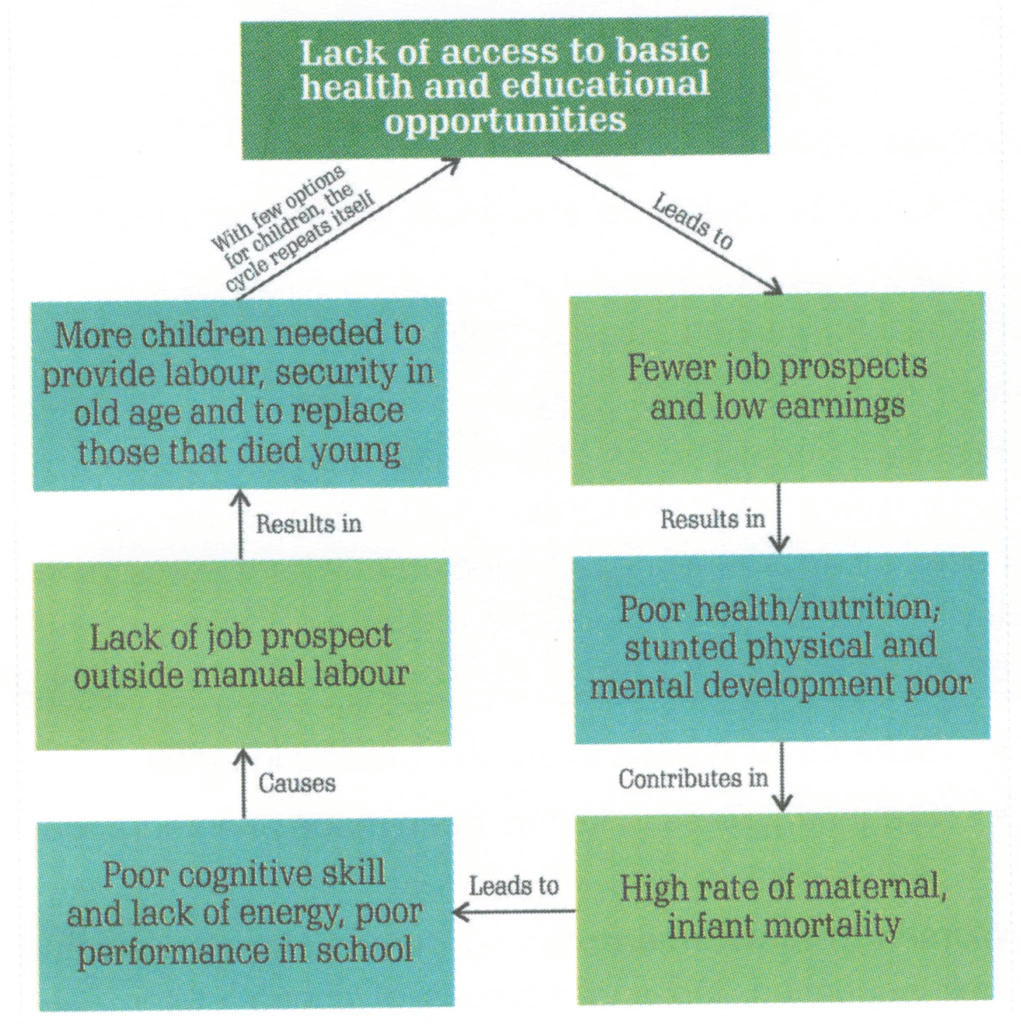
With little access to health care and education, the next generation is likely to repeat the cycle. Poverty affects them socio-economic development which is seen as one of the major causes for population growth.
Population Control
Family Planning: Family planning implies limitation of the family to a number considered appropriate to the resources of the family as well as proper spacing between the family. Family planning programme involves a coordinated group of activities maintained over a period of time and bringing the change in the child bearing behavior of females. The aim is to improve the health status of women and their children and reducing birth rate thus reducing the population growth rate of the country.
Components of family planning includes:
- Information, Education and communication activities
- Contraceptive: supplies and services
- Training of personnel.
- Research
- Administrative Infrastructure
Since 1977, the Indian family programme is known as the family welfare programme with greater emphasis on the welfare approach to the problem.
Population Policy in India
India has had an official population policy for more than a half century. In fact, India was perhaps the first country to explicitly announce such a policy in 1952. The population policy took the concrete form of the National Family Planning Programme. The broad objectives of this programme have remained the same- to try to influence the rate and pattern of population growth in socially desirablem directions. In the early days, the most important objective was to slow down the rate of population growth through the promotion of various birth control methods, improve public health standards, and increase public awareness about population and health issues.
The Family Planning Programme suffered a setback during the years of the National Emergency (1975-76). Normal parliamentary and legal procedures were suspended during this time and special laws and ordinances issued directly by the government (without being passed by Parliament) were in force. During this time the government tried to intensify the effort to bring down the growth rate of
population by introducing a coercive programme of mass sterilisation. Here sterilisation refers to medical procedures like vasectomy (for men) and tubectomy (for women) which prevent conception and childbirth. Vast numbers of mostly poor and powerless people were forcibly sterilised and there was massive pressure on lower level government officials (like school teachers or office workers) to bring people for sterilisation in the camps that were organised for this purpose. There was widespread popular opposition to this programme, and the new government elected after the Emergency abandoned it.
The National Family Planning Programme was renamed as the National Family Welfare Programme after the Emergency, and coercive methods were no longer used. The programme now has a broad-based set of sociodemographic objectives. A new set of guidelines were formulated as part of the National Population Policy of the year 2000.
National Population Policy: India had framed a national policy in 2000 which enumerates certain sociodemographic goals to be achieved. The policy identified certain immediate objectives for meeting the unmet demands so as to achieve population stabilization and others.
National Population Policy (NPP), 2000
The policy aimed to integrate education, Panchayati Raj Institution, women empowerment, community initiative in the domain of population control. It replaces the word family planning by family welfare.
Objectives:
- Immediate objective to address the unmet needs for, contraception, health care infrastructure and health personnel and to provide integrated service delivery for basic reproductive and child health care
- Medium term objective to bring the total fertility rate to replacement level by 2010.
- Long term objective to achieve stable population by 2045.
Broad Targets:
- Reduce Infant Mortality rate to 30, child, reproductive health through addressing the unmet needs for basic reproductive and child health services, supplies and infrastructure.
- Make school education up to age 14 free and compulsory and reduce dropouts at primary and secondary school levels to below 20 percent for both boys and girls.
- Reduce maternal mortality rate to 100.
- Achieving universal immunization of children against all vaccines preventable diseases.
- Achieve 80% of institutional delivery and 100% delivery by trained professionals and 100% registration of births, deaths, marriage and pregnancy.
- It envisaged the target of stable population by 2045 (which was later pushed back to 2065)
- Improving the availability of contraceptives and strengthening the health and family welfare services. It has been criticized on many accounts as it provides cash based incentives for small family norm but monetary incentives do not change habits and behaviours based on social norms. Also NPP-2000 emphasized on the role of Panchayati Raj Institutions but what their role would be has not been clearly mentioned. It rejected any form of coercion but many state governments continued with their coercion policy. Coercion is mostly used in the form of disincentives. Disincentives imposed by state governments are often anti poor and anti-women.
Government Schemes:
Government has primarily focused upon family planning activities for achieving population stabilization. Due to the efforts of the government the decadal growth rate of the country has declined from 21.54% for the period 1991-2001 to 17.64% in 2001-11. Family welfare programmes are an important component of the family planning process and various family welfare programmes have been launched over the years:
- Janani Suraksha Yojana which aims at reducing maternal and neonatal deaths by promoting institutional delivery by offering cash assistance.
- Integrated Child Development Scheme promotes holistic development, immunization care and nutrition of the children below six years of age and proper nutritional and health education of pregnant and lactating mothers.
- Universal Immunization programme.
- Pradhan Mantri Swasthya Suraksha Yojana aiming at correcting the imbalances in availability and affordability of tertiary level healthcare.
- Indira Gandhi Matritva Sahyog Yojana.
- Scheme for the home delivery of contraceptives by ASHAs at the doorstep of beneficiaries.
- Scheme for ASHAs to ensure spacing in births.
- Pregnancy Testing kit has been made an integral part of ASHA kit.
Women Empowerment:
Giving women choice regarding their education, job and methods of contraception have been found to be more viable alternatives for controlling population rather than forced and ‘quick-fix’ methods like sterilization, abortion and other coercive methods. The Economic Survey (2015) called for women empowerment for economic growth.
Positive Externalities of Women Empowerment:
- It would solve the menace of child marriage which is one of the prime reasons behind high fertility rate in the country.
- Education would bring down the fertility rates and allow women to understand the need for gap between births.
- Empowering women and having say in matters like child birth would ensure an healthy and aware society.
- Women empowerment would give women a voice against the patriarchal mindset prevalent in the Indian society.
Education:
Education forms the backbone of individual and society. Once educated people understand the issues related with overpopulation. Education especially of women could do wonders. According to survey by Sample registration office in 2010:
• Fertility rates for illiterate women was around 3.4.
• Fertility rates for literate women was at 2.2.
• Women who have studied till 10th had fertility rates of 1.9.
• Women who have studied till 12th had fertility rates of 1.6.
Positive Externalities of Education on Overpopulation:
- Literacy rate has direct correlation with socioeconomic development of the population which helps in improved living condition and better ability to understand population control.
- Education often results in late marriages which shortens the span of fertility resulting in less number of children.
- Education is one of the prime requisites for women empowerment which helps in controlling the population.
Thus education helps in empowering the population in taking liberal decision with respect to population control and helps in shedding the orthodox mentality against it. People also needs to be made aware of the consequences of having too many children.
Adoption:
India is home to more than 30 million orphan children, according to one estimate. These children run
the risk of being trafficked or pushed into illegal works, with no or less scope for education. Adoption of these children, besides tackling the issue of overpopulation can assure these children the love of parents and better future.
Social Measure:
Population explosion being a social problem is deeply rooted in the society, so societal efforts are needed to remove such deep rooted evils.
- In India, the legal marriage for girls is fixed in India by law which requires effective implementation to curb the evil of child marriage.
- Empowering the women would help them in taking decision with respect to their fertility rate.
- Educating women would help in improving the literacy level of the population and their ability to take decision.
- Providing social security so that people don’t need to be dependent on others during old age. Moreover, unemployment and others also check the desire for more children.
- People need to be made aware of various government measures and contraceptive methods etc.
- The focus needs to move away from women sterilization which constitute around 97% of total sterilization and there is a need to promote male vasectomy which is less invasive and painful.
Economic Measures:
Economic measure would help in economic empowerment which helps in improving the standard of living which helps in the overall social development. Thus it makes people more aware and understand the ills of over population.
Some of the economic measures are as follows:
- Need for employment avenues in both rural and urban areas and need to check disguised employment in rural areas.
- Agriculture today still employs more than half of the workforce thus improving and development of agriculture would help in providing employment to large number of people.
- Improved standard of living is deterrent to large family norm as people with high standard of living prefer to have small family.
- Urbanization needs to be encouraged as it helps in reducing fertility rate.
- Lacking development leads to high poverty, high illiteracy, high discrimination, lack of awareness, lack of medical facilities thus leading to increased population growth.
Thus economic measures would help in reducing the fertility rate and acting as an incentive against high population.
Conclusion
Increasing population is becoming a major issue around the world and has adverse societal, environmental and human health problems. The growth rate is a function of birth rate, death rate, migration in a country and is increasing at a fast pace in the country. As the overpopulation regions clamour for more resources, it causes deforestation for food production, urban overcrowding and the spread for horrible diseases.
Several schemes and programmes has been initiated by government since Independence to curb overpopulation and has been to an extent successful in reducing the growth rate of population. There is need for a more focused approach in particular regions which still suffer from high population growth rate.
